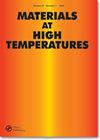Ni-Cr-Mo高温合金蠕变特性及等时应力-应变曲线研究
IF 0.9
4区 材料科学
Q4 MATERIALS SCIENCE, MULTIDISCIPLINARY
引用次数: 0
摘要
摘要c276高温合金具有良好的力学性能和耐腐蚀性,被认为是一种有潜力的先进核反应堆结构材料。研究了C276合金在650℃~ 700℃温度范围和140 ~ 430 MPa应力范围内的高温蠕变行为。在对数坐标系下,应力与最小蠕变速率拟合成线性关系。分别采用等温线外推法、Monkman-Grant关系法和Larson-Miller参数法对断裂时间进行寿命预测分析。采用参数法建立了蠕变条件下的等时应力-应变曲线,作为表征应力-应变-时间关系的手段。利用扫描电镜对断裂试样的断口形貌进行了表征,以阐明断裂机理。项目资助:国家自然科学基金(no. 52071330,51901241),上海市科学技术委员会研究项目(no. 19DZ2200300),国家重点研发计划项目(no. 2200300);2021YFB3700605),中国科学院上海应用物理研究所青年潜力计划和中国科学院战略重点研究项目(XDA02004210)。披露声明作者未报告潜在的利益冲突。本研究得到国家自然科学基金资助[52071330];国家自然科学基金[51901241];中国科学院战略重点研究项目[XDA02004210];上海市科委科研项目[19DZ2200300];国家重点研发计划[2021YFB3700605]。本文章由计算机程序翻译,如有差异,请以英文原文为准。
Study on creep characteristics and the isochronous stress–strain curve of Ni-Cr-Mo superalloy
ABSTRACTC276 superalloy is considered as a potential structural material for advanced nuclear reactor with good mechanical properties and corrosion resistance. High-temperature creep behaviour of C276 alloy was investigated in the temperature range of 650°C–700°C and at stresses of 140–430 MPa. A linear relationship was fitted between stress and minimum creep rate in the logarithmic coordinate system. The rupture time is analysed for life prediction in terms of isotherm extrapolation method, Monkman–Grant relation, and Larson–Miller parameter method, respectively. The isochronous stress–strain curves as a means of representing stress–strain–time relations under creep conditions were established by the parameter method. The fracture surface morphology of ruptured specimens was characterised by a scanning electron microscope to elucidate the failure mechanism.KEYWORDS: Ni-Mo-Cr superalloycreep rupturelife predictionisochronous stress–strain curve AcknowledgmentsThis work was supported by the National Natural Science Foundation of China (Grant nos. 52071330, 51901241), the Research Project of Shanghai Science and Technology Commission (19DZ2200300), the National Key Research and Development Program (Grant no. 2021YFB3700605), the Young Potential Program of Shanghai Institute of Applied Physics, Chinese Academy of Sciences and the Strategic Priority Research Program of the Chinese Academy of Sciences (XDA02004210).Disclosure statementNo potential conflict of interest was reported by the author(s).Additional informationFundingThe work was supported by the National Natural Science Foundation of China [52071330]; National Natural Science Foundation of China [51901241]; the Strategic Priority Research Program of the Chinese Academy of Sciences [XDA02004210]; Research Project of Shanghai Science and Technology Commission [19DZ2200300]; the National Key Research and Development Program [2021YFB3700605].
求助全文
通过发布文献求助,成功后即可免费获取论文全文。
去求助
来源期刊

Materials at High Temperatures
工程技术-材料科学:综合
CiteScore
1.90
自引率
15.40%
发文量
58
审稿时长
>12 weeks
期刊介绍:
Materials at High Temperatures welcomes contributions relating to high temperature applications in the energy generation, aerospace, chemical and process industries. The effects of high temperatures and extreme environments on the corrosion and oxidation, fatigue, creep, strength and wear of metallic alloys, ceramics, intermetallics, and refractory and composite materials relative to these industries are covered.
Papers on the modelling of behaviour and life prediction are also welcome, provided these are validated by experimental data and explicitly linked to actual or potential applications. Contributions addressing the needs of designers and engineers (e.g. standards and codes of practice) relative to the areas of interest of this journal also fall within the scope. The term ''high temperatures'' refers to the subsequent temperatures of application and not, for example, to those of processing itself.
Materials at High Temperatures publishes regular thematic issues on topics of current interest. Proposals for issues are welcomed; please contact one of the Editors with details.
 求助内容:
求助内容: 应助结果提醒方式:
应助结果提醒方式:


